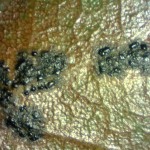Blog article #3 by Marissa McCarthy (for partial fulfillment of BESC 484 requirement)

Trabutia quercina is an ascomycete fungus that specifically targets species of oak trees, creating a disease commonly known as Tar spot on the leaves. The Tar spot was found on a live oak sample that was sent into the lab from a private residence. This fungus is characterized by the formation of black, blotchy lesions on the upper side of oak leaves, especially along the veins of the leaves. The lesions gradually expand and as additional layers of cells are formed, it becomes raised and blister-like. Conidiomata are simple structures that form first, near the center of the lesion and form one-celled conidia. As the conidiomata mature they become flat and dull black. Ascomata then form within the lesion forming a circle surrounding the existing conidiomata. The ascomata can be differentiated by having a shiny black appearance and a short conical shape. Asci are characterized as having a single thickened apical wall that are clavate and breaks down easily. At formation the ascus is thick walled and as it matures the wall is thinned, stretched and distorted by the mature ascospores.
Ascospores are small, broad and crescent shaped that disperse via wind or water splash. Tar spot diseases usually manifest during early summer months or in the fall, when climate is conducive to the production of structures on the leaf and fungal sporulation. Infection lesions are most commonly found in the lower limbs of affected trees. Usually Tar spot is not exceedingly damaging to the oak, however severely affected leaves will drop from the tree, while slightly affected leaves will remain attached until natural leaf shed.
Control measures include collecting and removing leaf litter in which the fungus can overwinter in and will serve as a source of inoculum, as well as fungicide treatment.Other species of Tar spot can be found and affect many other species of trees.
Mentor comment: Great job. Good photos to accompany informational post!





